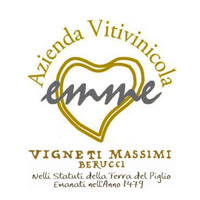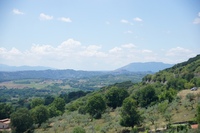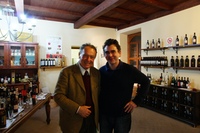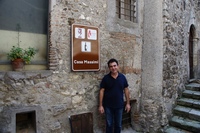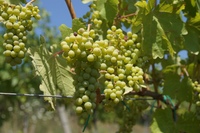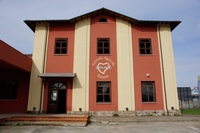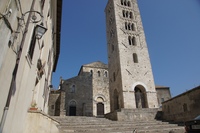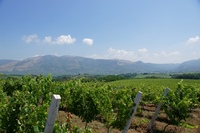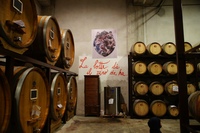生産者: マッシミ ベルッチ (Vigneti Massimi Berucci)
1479年からラツィオ州でワイン造りを続けているベルッチ家は、2008年からDOCGに格上げになり、現在少しずつその名をあげてきているCesanesedel Piglioの地域を代表するワインの生産者です。またこのファミリーの名前は、フロジノーネ県の博物館にある古文書にその名が記されているといわれています。
ラツィオ州フロジノーネ県のコムーネの一つであるアナーニ(Anagni)という地域は、中世からローマ方法の避暑地として別荘があった場所で、由緒あるまた歴史の深い地域として知られています。このフロジノーネ県周辺では中世初期から修道士の手でワインが造られ、異民族の進入時の困難にも耐えて生き残った銘酒とされています。また、この地域でのみ消費される量しか作られていなかった門外不出の銘酒は、この中世にはローマ方法への奉納されていたといわれています。
ラツィオ州で有名なワインといえば、D.O.C. 白ワインで北のエストエストエスト(Est! Est!! Est!!)か南のフラスカーティ(Frascati)でしたが、このチェザネーゼの2008年のD.O.C.G.の格上げで、一気に注目を集めるワインとなりました。
Cesaneseの生産地の中で4つの主な畑の一つであるCesal Cervinoは、海抜450mの高台で、火山岩の土壌なか、ギュイヨー(Guyot)と呼ばれるぶどうの仕立て方法で栽培されています。また、チェザネーゼ・ダッフィーレ(Cesanesed’Affile)という品種のブドウを100%使い、濃いルビー色で厚みがあり、野イチゴやプルーンの香りに、酸味とこまやかなタンニンが上手に絡んでいてとても口当たりのいいワインで、同時にこのワインにはどっしりとした強さを秘めているのが特徴です。
Berucci family has been producing wine called “Cesanese del Piglio” since 1479 in Frosinone, Lazio. For over 500 years of wine making history, Berucci family name is written in ancient document archived in comune of Frosinone. This wine has finally upgraded to DOCG and the Berucci family wine are now becoming more and more appearing to market.
1 of the area called Anagni was famous for the summer house of Pope in middle ages. Since then, this area was famous for wine producing by local monks and it kept as it is until today while some ethnic tribes were tried to invade the area. The production of this wine has been so limited and it was only available in this area in the past. It is said that some of the best quality one was delivered to Pope in summer house.
Società Agricola Emme was founded in 2004. The intention of the founders was to create a modern company but with deep roots in the past. So, they joined the past, being the history of Cesanese and the wine culture represented by Berucci’s family, with the current competence and trade skills of Piccirilli’s family (of millers origin) and combined them with Mr Tagliente’s enologic experience and modern technologies which are to be found within the Cesanese del Piglio cooperative. The logo of our company actually represents this tie up with the past. The ancient heart symbol of Massimi di Piglio, with the word “EMME” inside of it, where the two “M”s mean the new millennium in Roman numbers.
EMME's first goal was to find and cultivate 30 hectars of vineyards in the best areas inside the Cesanese del Piglio centre of production so that we could produce grapes of good quality, from which they could get excellent wines. At the same time, EMME wanted to combine the wine production with the production of dairy and sweets which contain wine, must and passitos (strong sweet wine made from raisins) amongst their basic ingredients.
In 2004, Emme bought the vineyards of Casal Cervino, Torretta, Valle Bianca and Via Piana of Manfredi Berucci, all of which are in Piglio. In the same year EMME had the chance to use the former cooperative winegrowers’ association building, an historical building located on Via Casilina in Anagni. Soon after the acquisition of the property, EMME started to restructure and to re-establish the vineyards and to restore the building in Anagni, with a view to it becoming the point of sales for the company.
In 2005 Emme bought the vineyards in Vignali and in 2007 bought a piece of land in Valle Bianca, close to the town of Anagni.
In 2011, Caseificio San Lorenzo, the cheese factory in Valle, led by Giuliana Lauretti, joined Società Agricola Emme.
Today, EMME has 32 hectares, 25,7h vineyards and 1000 olive trees. The vineyards are divided in 5 parts, according to their width, sun exposition, soil features and variety of plants. The planting layout of the vinesrepresents the right starting point for our wines.
They are:
-> Casal Cervino: located in the territory of Piglio, at the foot of the mountain, some 340 to 390 meters above sea level and facing South/South-East. The red soil is of medium texture and with the consistent presence of limestone rocks, is able to give the grape and then the wine its structure together with its peculiar and distinctive aroma.
In a single plot of over 8.5 hectares, EMME has:
>Our oldest vineyard of 4.2 hectares, planted in 1963 by Manfredi Berucci and now belonging to the Massimi Company, producing the ancient Cesanese di Affile and Comune red vines as well as the white Passerina and Romanesca, all from the necessary wild rootstock within a 120 x 353 double guyot layout and cultivated close to olive trees. This is the vineyard which we have operated, since the early 90's, to produce the selection of Cesanese di Affile, Passerina del Frusinate and other white grape varieties. These are the varieties from which all the new vines that we introduce in the new inplants come from.
>A young vineyard of 2 hectares planted in 2007 with the Cesanese di Affile and Passerina variety of grapes. It covers about 3500 square meters, in a 220 x 80 layout and cultivated inspurred cordon.
From here, the grapes for" Cesanese Casal Cervino Maximo Berucci" have been produced by Manfredi since 1978. The limestone rocks make the soil light, fresh and contribute to an excellent supply of water. These soil features, along with the sun exposure, are the reasons for the production of a grape, so exceptional, that "CASAL CERVINO" was elected the best production area of the Cesanese Piglio in the AIS publications.
-> Torretta: in the territory of Piglio, is located on a hill 372 meters above sea level and facing south with reddish soil (soil tuff, easily crumbling and rust-coloured) in a single plot of over 3.5 hectares. We planted 3 hectares of vineyards between 2005 and 2006, all in the Cesanese di Affile variety, in a 100 x 250 layout and cultivated in spurred cordon.
This vineyard is mentioned in a report on "Statutes of the land of Piglio" issued in 1479
-> Valle Bianca: is cultivated in the territory of Anagni and Piglio, on a hill, in two plots. The first consists of about 4 hectares, 340 meters above sea level, facing south, on white soils (clays and sandstones of pale yellowish colour), with a vineyard of 2.2 hectares planted in 1975 for the Passerina Cesanese variety in a 250 x 300 layout and cultivated by an alberate training system (pergula);
The second consists of about 5 hectares, 360 meters above sea level, on reddish / white soil with a vineyard of 4.8 hectares planted in 2009, for the Affile Cesanese and Aglianico varieties, in a 100 x 240 layout and cultivated in spurred cordon.
This land is now being cultivated again as a vineyard, after the disastrous arrival of the phylloxera. Plans of this territory dating back to 1939 show that it used to be a place of countless vineyards and that it was populated by many families of farmers.
-> Vignale: is cultivated in the territory of Piglio, on the hills, from 330 to 350 meters above sea level, facing South / South-East, with reddish soil, in a single plot of 5 hectares, containing a
1 hectare vineyard, cultivated between 1965 and 1970 with the Passerina variety, in a 120 x 200 double-Guyot layout; and a 3.5 hectares vineyard planted in 2006 for the Cesanese di Affile and Passerina (about 1 hectare) varieties, in a 120 x 200 layout and cultivated in bilateral cordons.
This vineyard is dominated by a huge oak which witnessed over the centuries, the creation, the cultivation and the recreation of vineyards and is called "Vignali."(the old name of this land means vineyards).
-> Pantanello/Fossa del Lupo: located in the territory of Anagni, is positioned on the lower hills, some 200 meters above sea level and on white soil, in two lots. We rent and cultivate a 4 hectares vineyard which was planted in 1973 with Passerina and Cesanese di Affine (0.5 hectare) varieties in a 300 x 300 layout and cultivated using the pergola system.
Moreover, we have some other pieces of land being 0.3 to 0.9 hectares in width which we planted between 1963 and 2006 with Cesanese di Affile and Passerina varieties which provide, in total, 2.3 hectares, of espalier cultivation.
The cultivation of the grapes aims to produce a quality product. We run the new implants in about 15 hectares, in a different way from the old ones which occupy about 10 hectares. In the first, there is a constant experimentation to balance the quality of young wines. In the second, the balance is now natural. We produce 35 to 90 quintals per hectar, according to the age of the vineyards, the pruning, the soil and the possible natural decrease of the plants. We process the Passerina vines in this way and we can obtain between 50 to 150 quintal per hectar. Usually, the harvest begins the first week of October and goes on until the first week of November.
The winemaking takes place in the cellar of the Cooperative Cesaese del Piglio, where the lots are divided according to the harvest. On the basis of their features different winemaking takes place but this depends on the decision of the enologist Domenico Tagliente, who is assisted by Daniele Proietti who joined the cooperative in 2007.
In the winemaking of the red wines, grapes keep their skin. The wine maker containers can take 25 to 150 hl and the fermentation lasts from 7 to 10 days. The containers have a controlled temperature, managed by a program, as well as pumpovers. We have also introduced a 75-Hl innovative winemaker, which excludes the use of pumps for pumpovers, whilst leaving the seeds in the de-stemmed grapes in the liquid, thus exploiting the Archimedes' principle of increasing the pressure in the tank. The results are exciting as witnessed by the "Casal Cervino superiore riserva DOCG 2008”.
A different winemaking process is reserved for the Passito Cesanese, whose grapes are left in the fruitstorage on a plateau, to be vinified in January. The vinification of white wines, after a light treading, usually requires the immediate separation from the skins, except for a small amount that we sometimes use for Casal Cervino and to Passerina bianco. Its fermentation takes place in temperature controlled silos. After the fermentation, the wines are kept in steel tanks, while some lots are aged in wood barrels which have a 220 to 2500 liters capacity.
EMME is working to achieve our first objective, which is to acquire approximately 6 hectares to cultivate with vineyards, and at that point we will restructure the oldest vineyards.
Grape production tends to be about 250,000 kg per year which is the equivalent of about 160,000 litres of wine or about 200,000 bottles of our Cesanese Piglio Hyperius DOCG, Casal Cervino, Vigne Nuove and the Passerina Frusinate Hyperius, Casal Cervino Spumante, the Passito varieties and the distillates.
We recommend that you check the bibliographical notes from the archives of 'Casa Massimi”, Via Maggiore, 121 Piglio:
-BottiniO.- O-Venezia M., "Il Cesanese del Piglio", 1942
-Enoselezione, year IV, January / February 1968, pages. 5 and 6, "Il Cesanese del Piglio". 1968
-Historical notes from Cantina Sociale Cesanese Piglio, flyer 2004
-Mario Soldati "Vino al Vino" 1955 pages. from 550 to 555.
プリマヴェーダ ページトップへ
